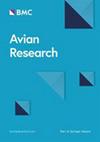中国东部沿海湿地越冬鸭的种子传播
IF 1.7
2区 生物学
Q1 ORNITHOLOGY
引用次数: 0
摘要
鸭类是许多植物种子传播的重要媒介,为湿地植物群落的再生做出了重要贡献。然而,对不同种类鸭子食性的时间变化以及种子传播的动态和差异的研究仍然有限。本研究分析了中国江苏省东部大丰市滨海湿地2022-23年和2023-24年12月至次年2月鸭群落的多样性和不同种类鸭粪便中种子的多样性。在四个栖息地共记录到 13 种鸭类,其中以斑嘴鸭(Anas zonorhyncha)和野鸭(A. platyrhynchos)的数量最多。不同栖息地鸭类的多样性和数量各不相同,其中潮滩栖息地鸭类的多样性和数量最多。我们在潮滩收集了斑嘴鸭、凫(Mareca strepera)、野鸭和欧亚凫(A. crecca)的粪便样本,从中获得了属于 7 科、13 属和 15 种不同植物的种子。四种鸭子的种子散播存在明显差异,且随季节而变化。鸦雀和普通凫在种子散播方面表现出更显著的多样性,其粪便中含有更多种类的植物种子,这与它们更广泛的食性和生态适应性有关。此外,粪便中种子数量的季节性变化反映了栖息地中种子的可获得性以及鸭子对环境变化的反应,而不同种类鸭子摄入种子数量的变化可能与年际天气条件变化有关。本研究的结果将为了解沿海湿地鸟类介导的种子传播机制提供一个新的视角,并为亚洲鸭的种子传播提供初步的见解。本文章由计算机程序翻译,如有差异,请以英文原文为准。
Seed dispersal by wintering ducks in a coastal wetland of eastern China
Duck species are important vectors for seed dispersal of many plants, contributing significantly to the regeneration of wetland plant communities. However, research on the temporal changes in diet and the dynamics and differences of seed dispersal among different duck species is still limited. In this study, we analyzed the diversity of duck community and the diversity of seeds in the feces of different duck species from December to February for 2022–23 and 2023–24 in the coastal wetland of Dafeng, eastern Jiangsu Province, China. A total of 13 duck species were recorded in the four habitats, of which Spot-billed Ducks (Anas zonorhyncha) and Mallards (A. platyrhynchos) were the most abundant. The diversity and abundance of ducks vary across different habitats, and tidal flat supports the greatest diversity and abundance of ducks. We collected fecal samples from Spot-billed Ducks, Gadwalls (Mareca strepera), Mallards, and Eurasian Teals (A. crecca) in the tidal flat, from which seeds belonging to 7 families, 13 genera and 15 different plant species were obtained. There were significant differences in seed dispersal among the four duck species, which varied with the season. Gadwalls and Common Teals showed more significant diversity in seed dispersal, with their feces containing a greater variety of plant seeds, which is related to their broader dietary range and ecological adaptability. Furthermore, the seasonal variation in the number of seeds per feces reflected the availability of seeds in the habitat and the response of ducks to environmental changes, while variations in seed intake among different duck species may be associated with inter-annual weather condition changes. The results of this study will provide a new perspective for understanding the mechanisms of bird-mediated seed dispersal in coastal wetland and offer preliminary insights for the seed dispersal by Asian ducks.
求助全文
通过发布文献求助,成功后即可免费获取论文全文。
去求助
来源期刊

Avian Research
ORNITHOLOGY-
CiteScore
2.90
自引率
16.70%
发文量
456
审稿时长
46 days
期刊介绍:
Avian Research is an open access, peer-reviewed journal publishing high quality research and review articles on all aspects of ornithology from all over the world. It aims to report the latest and most significant progress in ornithology and to encourage exchange of ideas among international ornithologists. As an open access journal, Avian Research provides a unique opportunity to publish high quality contents that will be internationally accessible to any reader at no cost.
 求助内容:
求助内容: 应助结果提醒方式:
应助结果提醒方式:


